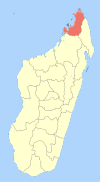|
Antsiranana
Antsiranana (Malagasy: Antsiranana Malagasy pronunciation: [antsʲˈraŋanə̥]), named Diego-Suarez prior to 1975, is a city in the far north of Madagascar. Antsiranana is the capital of Diana Region. It had an estimated population of 115,015 in 2013.[1] HistoryAt the beginning of the 16th century, a Portuguese squadron of 13 ships crisscrossed the Indian Ocean; One of these ships went adrift, and its captain, Diego Diaz, was therefore the first European to discover the Big Island on August 10, 1500.[citation needed] In February 1506, Admiral Herman Suarez recognized the place and so Antomabokala, former capital of Ankarana, acquired its name of Diego Suarez, which comes from the contraction of the first name of the captain and the name of the Admiral.[citation needed] In 1635, the bay was mentioned for the first time under this name by the French pilot Berthelot, author of an oriental map of Africa and Madagascar. In 1824, the bay was explored by the English hydrographer Owen, then in 1833, Captain Bigeault, commandant of La Nièvre, traveled the North East coast to carry out hydrographic surveys.[citation needed] In the 1880s, the bay was coveted by France, which desired it as a coaling station for steamships. After the first Franco-Hova War, Queen Ranavalona III signed a treaty on December 17, 1885, granting France a protectorate over the bay and surrounding territory, as well as the islands of Nosy-Be and Ste. Marie de Madagascar.[citation needed] The French took possession of their new colony and the Bay of Diego Suarez (also called Bay of Antomboko at that time).[citation needed] It was then called Etablissement français de Diego-Suarez (French Establishment of Diego-Suarez) and was placed under the command of Frigate captain Caillet who is the founder of the city of Diego Suarez.[citation needed] The first barracks were built at Cap Diego. The first habitants of the new colony were Creoles from Réunion & Mauritius, as well as from the French possession of Toamasina, Nosy Be, Ile Sainte-Marie, Mayotte and Mahajanga.[citation needed] Run away slaves (Makoas), Antankarana and Sakalava made up another big part of the population. In 1886, the colony had a population of 2500 habitants.[citation needed] In 1887, a civil governor, Froger, replaced Caillet. In 1888, the islands of Nosy Be and Ile Sainte-Marie were attached to the colony.[2]  In 1900, the Decauville railway at Diégo Suarez was built.[3] The Second Pacific Squadron of Imperial Russia anchored and was resupplied at Diego-Suarez on its way to the Battle of Tsushima in 1905.[citation needed] On 21 March 1909, the first bricks of the cathedral were laid down. In 1919 there was an epidemics of the Spanish flu followed by an outbreak of the plague in 1920.[4] Still, in 1925 the Province de Diego-Suarez had 13695 habitants.  In 1942, Diego-Suarez was the primary objective of Operation Ironclad, the starting point of the Allied invasion and capture of Madagascar. The Allies were concerned that Japan would pressure Vichy France into granting use of Madagascar, as they had with French Indo-China during the previous year, and determined that the island should not be made a base for the interception of Allied shipping. Diego-Suarez, with its superb harbour and a concentration of government officials, was selected as the initial invasion point. The Japanese responded with an attack by midget submarines on the British naval forces in the harbour, damaging the battleship HMS Ramillies and sinking the oil tanker British Loyalty.[5] France continued to operate a military base in the city following Malagasy independence in 1960.[citation needed] Between 1973 and 1975, French forces were withdrawn. Postage stampsEducation The University of Antsiranana was founded in 1976. Lycée Français Diego Suarez, or Lycée Français Sadi-Carnot, is a French international school in Antsiranana. Historically it was the Collège français Sadi Carnot.[6][7] Transport Antsiranana is situated on Antsiranana Bay, one of the largest deep-water harbours in the Indian Ocean, but the remote location, and, until recently, a bad road to the south, rendered it unimportant for freight traffic. There is a cruise port with periodic visits. Arrachart Airport provides communication primarily with other parts of Madagascar. GeographyClimateAntsiranana has a tropical savannah climate (Aw) with long, hot summer-like weather that lasts year round cut into two seasons; a wet season which lasts from December to March and a dry season which lasts the rest of the year with rainfall being uncommon but not impossible.
Places of worship Among the places of worship, they are predominantly Christian churches and temples:
There are also Muslim mosques. See alsoReferences
External linksWikimedia Commons has media related to Antsiranana. Wikivoyage has a travel guide for Antsiranana.
|
||||||||||||||||||||||||||||||||||||||||||||||||||||||||||||||||||||||||||||||||||||||||||||||||||||||||||||||||||||||||||||||||||||||||||||||||||||||||||||||||||||||||||||||||||||||||||||||||||||||||||||||||||||



